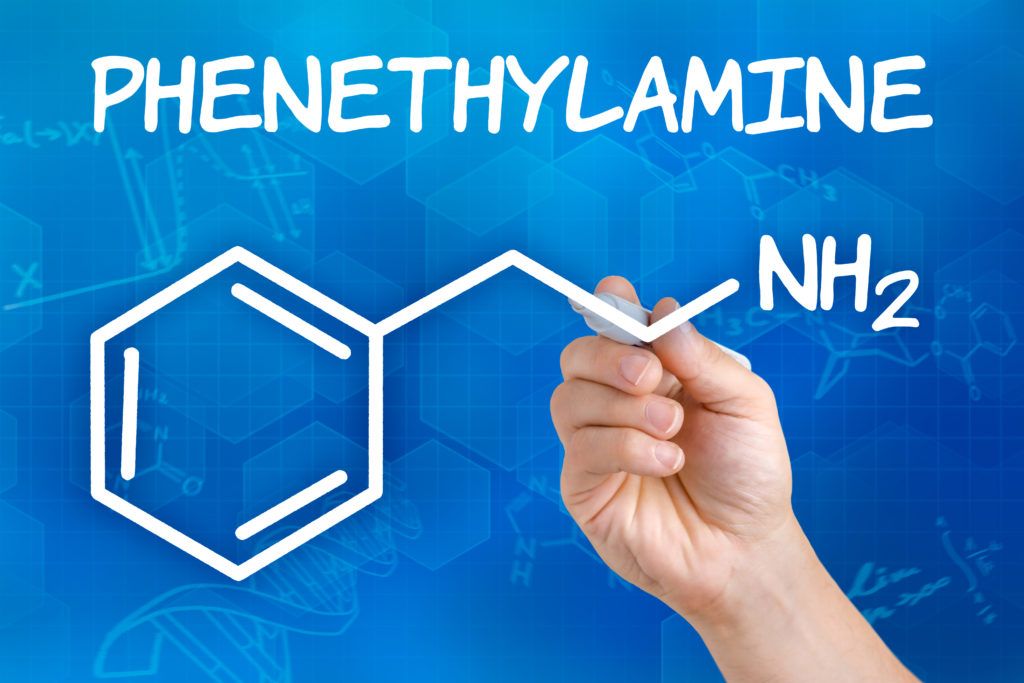
Psychoactive mushrooms (aka psilocybin mushrooms or magic mushrooms) have recently received considerable attention in the popular news media. For the most part, reports focus on either the magic mushrooms themselves or the molecule psilocybin. A few articles point out that psilocin is actually the active molecule.1
Magic mushrooms contain many other active compounds. One of them is phenethylamine (PEA).2 Scientists almost never acknowledge this molecule. This is an important issue because several magic mushroom compounds are probably involved their pharmacology and eliciting the overall psychedelic effect (aka the entourage effect).
Phenethylamine is Present in Magic Mushrooms
Consider these facts about phenethylamine:
- It acts as a central nervous system stimulant in humans. It is similar to amphetamine in its action in that it causes the release of norepinephrine and dopamine.
- It is found in a wide range of species throughout the plant and animal kingdoms.3
- Phenethylamine has been quantifiably measured in multiple collections of psychoactive mushrooms.2
Phenethylamine Shows a Need for Improving Psilocybin Chemistry
The presence of phenylethylamine in magic mushrooms shows why it is important to distinguish mushrooms from the collection of molecules inside those mushrooms.
The path to better psilocybin products will begin by treating magic mushrooms as collections of magic molecules. Even psilocybin is only present in about 1-2% of the dry mass of mushroom flesh.4 This means that 98-99% of that mushroom is comprised of other types of molecules including carbohydrates, fats, proteins, and perhaps other psychoactive compounds like phenylethylamine. How do these compounds work together to create the psychedelic effect? Right now, no one knows.
As evidenced by the prevalence of magic mushroom language, psilocybin technology is presently viewed from a mycologist’s perspective. That perspective is essential to cultivating and/or identifying magic mushrooms. However, future advances in treating conditions like anxiety and depression will require viewing these mushrooms from a chemical perspective.

There’s a problem with your math, and the fact that there’s no site of sources on there being phenethylamine in mushrooms. Kinda just made a false claim. But now the really shame the writer and editor of this particular snippet. Your math is wrong big time. The most potent psilocybin mushrooms only has a psilocybin content of 1.37% of dry weight. That is out of 100% of the weight of the mushroom. What was claimed was the other 98.63% (had your numbers been right) was composed of other unknown psychoactive compounds; which is frustratingly wrong. It makes me want to… Read more »
Hello, and thank you for pointing out the missing citation for the reference supporting the presence of phenethylamine in magic mushrooms. However, I don’t see evidence that our math in the article is wrong, as you claim. On a side note, your math uses a value of 1.37% for the psilocybin content of mushrooms but you don’t supply a reference. Also, please explain why it is “frustratingly wrong” that the remaining 98.63% (using your numbers) of the mushroom flesh contains other unknown psychedelic compounds. And please clarify how we are practicing “pseudoscience” and being “illogical.” PSR strives to provide the… Read more »
That’s because a large fraction of mushroom weight is from nutrients and carbohydrates! Let’s say that shrooms are only 1.37% psilocybin. If only 1.37% percent is psilocybin, then 98.63% is EVERYTHING ELSE IN THE MUSHROOMS, including things like protein and fiber! There is NO WAY that 100% of that weight is from psychedelic compounds! Shrooms have plenty of non-psychedelic contents. That’s COMMON SENSE! Do you not see what’s wrong with this assumption!? Stop spreading misinformation! You need to either heavily edit this article or delete it altogether. If you can’t even get THAT right, then I can’t believe your claims… Read more »
I clarified the sentence in question. Please dispense with the ad hominem attacks.
Are you unable to read or comprehend things properly or something? No where was it stated that 100% of the mushroom is made of psychoactive compounds, just that the 98.63% of the mushroom that isn’t psylocybin also contains other psychoactive compounds. Nothing about that implies that all of it is made up of psychoactive compounds, just that it contains some.
Here’s a link to the study showing phenylethylamine in Psilocybe semilanceata
http://en.psilosophy.info/presence_of_phenylethylamine_in_hallucinogenic_psilocybe_mushroom_possible_role_in_adverse_reactions.html